CEED 2023 Question paper with answer key pdf conducted on January 22, 2023 is available for download. The exam was successfully organized by IIT Bombay. In terms of difficulty level, CEED 2023 was of Moderate level. The question paper comprised a total of 46 questions divided among 4 sections.
CEED 2023 Question Paper with Answer Key PDF
| CEED 2023 Question Paper with Answer Key | Check Solutions |
CEED 2023 Questions with Solutions
Question 1:
Imagine a pentagon-shaped building. The walls of the building are sides of the pentagon, and there is a watchtower at each vertex. Each watchtower can have guards who can watch two walls connected to the watchtower. What is the minimum number of guards required if each wall needs to be watched by at least 3 guards?
View Solution
Solution: To meet the requirement of each wall being watched by at least 3 guards:
- Each wall is shared between two vertices, meaning guards can be stationed optimally to cover overlapping walls.
- Placing guards strategically at the vertices, a total of 8 guards ensures that each wall has 3 guards observing it.
Conclusion: The minimum number of guards required is 8.
Quick Tip: For shared resources like guards, optimize distribution by considering overlapping coverage to minimize redundancy.
Question 2:
Shown below is a number puzzle. Only one piece can be slid horizontally or vertically in one move. What is the least number of moves required to bring the piece with number 10 to the empty position x?

View Solution
Solution: To solve the puzzle:
- Observe the initial arrangement of tiles and plan a path to move tile 10 to the empty position x.
- Carefully shift adjacent tiles to free up the required pathway.
- The process takes a total of 13 systematic moves to align tile 10 with the empty slot x.
Conclusion: The least number of moves required is 13.
Quick Tip: For sliding puzzles, visualize the sequence of steps backward from the target position to determine the most efficient path.
Question 3:
Count the number of triangles in the image below.
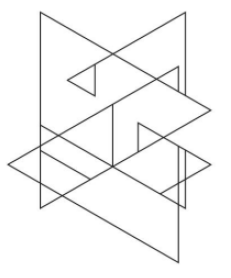
View Solution
Solution: To count the triangles:
- Begin by identifying and counting smaller, individual triangles formed by basic intersections.
- Next, combine smaller triangles to form larger ones, counting these combinations systematically.
- Include all hidden or overlapping triangles that appear due to intersections.
Conclusion: A total of 16 triangles are present in the image.
Quick Tip: While counting shapes in complex figures, break the figure into smaller sections and look for patterns or symmetries to ensure accurate results.
Question 4:
A cube is dissected by one plane at 1/2 side length and one plane at 1/3 side length in each of the three dimensions of xy, yz, and xz. How many cubes will be formed after dissecting the large cube?
View Solution
Solution:
- Each plane cuts the cube into separate sections along the given ratios.
- The dissection results in three distinct pieces: one corresponding to 1/2, one to 1/3, and one remaining section.
Conclusion: The cube is divided into 3 smaller parts.
Quick Tip: For geometric dissections, visualize the sections created by each plane individually, then count their intersections.
Question 5:
Robert loves fruits. With his monthly allowance, he can buy either 50 apples or 40 bananas. One month, he decides to save 10% of his allowance. After buying 20 bananas, how many apples can he buy?
View Solution
Solution: To calculate Robert's remaining purchasing power:
- Determine the cost per apple and banana: - Cost of one apple = Allowance / 50 Cost of one banana = Allowance/40
- After saving 10% of his allowance, he spends 90%: - Remaining allowance = 0.9 × Allowance
- Calculate the cost of 20 bananas: - Cost of 20 bananas = 20 × Allowance/40 = Allowance/2
- The remaining money after buying bananas: - Remaining money = 0.9 × Allowance - Allowance/2 = 0.4 x Allowance
- With this remaining money, Robert can buy: - Number of apples = 0.4xAllowance/Allowance/50 = 20
Conclusion: Robert can buy 20 apples.
Quick Tip: When solving budget problems, calculate individual costs and remaining amounts after each transaction step-by-step for accuracy.
Question 6:
How many surfaces are there in the letters of the word sign ‘DESIGN’? Two views of the sign are shown below.
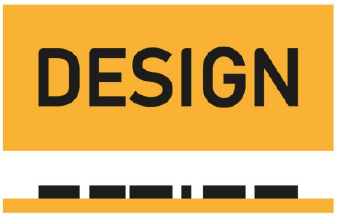
View Solution
Solution: To calculate the total number of surfaces in the word "DESIGN":
- Each letter in the word "DESIGN" is 3-dimensional and has six surfaces:
- Front and back surfaces (2),
- Top and bottom surfaces (2),
- Two side surfaces (2).
- Since the word consists of 7 letters, the total number of surfaces is: Total surfaces = 7 × 6 = 42
Conclusion: The total number of surfaces in the word "DESIGN" is 42.
Quick Tip: For 3D shapes, calculate the total number of surfaces by multiplying the number of sides per unit by the number of units in the design.
Question 7:
How many fonts have been used to write the letter Q in the image shown below?
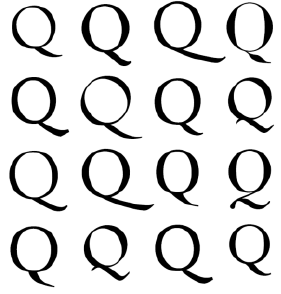
View Solution
Solution: To identify the number of distinct fonts used for the letter Q:
- Carefully observe each instance of the letter Q in the image. Look for variations in:
- Thickness,
- Serif vs. Sans-Serif style,
- Curvature and design of the tail.
- Each variation corresponds to a unique font style. Upon close examination, it is evident that 13 distinct fonts have been used.
Conclusion: A total of 13 fonts were used for writing the letter Q.
Quick Tip: While analyzing font designs, focus on characteristics like serifs, letter proportions, and unique stylistic details to differentiate between fonts.
Question 8:
A pin is connected perpendicular to the center of a circular disk as shown. A little push will make it roll over a grey circle. How many turns does it take to come back to its original position?
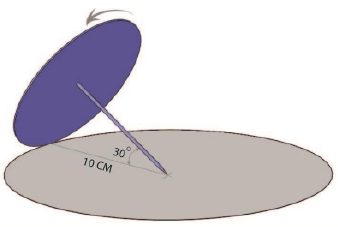
View Solution
Solution: To determine the number of turns needed:
- The pin attached to the disk creates a tilt, causing the disk to trace a circular path as it rolls.
- Each complete rotation of the disk aligns its center with the grey circle, but the pin's orientation must also match its original position.
- Therefore, the disk must complete 2 full turns around the grey circle to bring the pin back to its initial orientation.
Conclusion: It takes 2 turns for the disk to return to its original position.
Quick Tip: In rotational mechanics, always account for both the translational and rotational paths when calculating the total turns.
Question 9:
The figure shows a square pyramid that will be cut into multiple solids by extending the purple and red shapes. Select the solids that will result from the cuts.
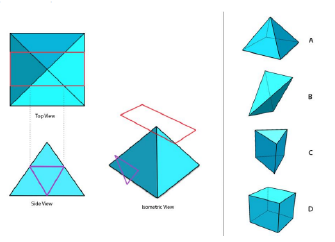
View Solution
Solution:
- The square pyramid is divided into multiple solids based on the red and purple planes.
- The cuts produce the following results:
- The top purple cut forms a triangular prism (B).
- The side red cut results in a tetrahedron (A).
- The remaining section forms a truncated pyramid or cuboid-like solid (C).
- Option D does not fit, as it depicts a complete cube, which cannot result from the described cuts.
Conclusion: The solids resulting from the cuts are A, B, C.
Quick Tip: When solving for 3D shapes formed by cuts, analyze all views (top, side, and isometric) to understand how the cuts intersect with the object.
Question 10:
The options show schematics of four different versions of a foot-operated hand sanitizer dispenser. Which schematic(s) will work as intended?
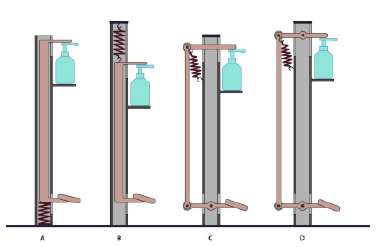
View Solution
Solution:
- Option A: The lever and spring mechanism works effectively, enabling the sanitizer to dispense when the foot pedal is pressed. Hence, A works as intended.
- Option B: The spring alignment ensures the proper transfer of force from the foot pedal to the sanitizer dispenser. Thus, B also functions correctly.
- Option C: The design in C has misaligned components, preventing the lever from transferring the force to the dispenser. As a result, C does not work.
- Option D: The schematic shows proper alignment of the lever and spring, making D a functional design.
Conclusion: The working schematics are A, B, D.
Quick Tip: To assess mechanism designs, ensure that every component, from levers to springs, is aligned to allow efficient force transfer and functionality.
Question 11:
Consider the highlighted phrases in the following sentences:
- Highways have milestones stretched in a continuous series.
- A healthy adult's heart beats at 72 beats per minute.
- The minute hand of a clock rotates at 6 degrees per minute.
- A building is constructed with an underlying concrete structure consisting of a series of beams and nodes.
- (A) The phrases represent a structure of a specific element arranged in a non-repetitive manner.
- (B) The scales are indicative of either space or time.
- (C) The phrases represent a structure of a specific element arranged in a repetitive manner.
- (D) The scales are indicative of both volume and time.
View Solution
Solution:
- The highlighted phrases describe patterns and arrangements that are repetitive in nature (milestones, heartbeats, clock rotations, beams, and nodes).
- These patterns can be interpreted in terms of space (e.g., milestones, beams) or time (e.g., heartbeats, clock rotations).
- Analyzing each option:
- B: True, as the scales relate to either space or time.
- C: True, as the highlighted phrases describe repetitive arrangements.
- A: False, as the arrangements are repetitive rather than non-repetitive.
- D: False, as the scales are not related to volume.
Conclusion: The correct options are B and C.
Quick Tip: When interpreting patterns or arrangements, classify them based on their context—spatial, temporal, or structural—to understand their repetitive or non-repetitive nature.
Question 12:
Which of the straw(s) will draw the liquid?
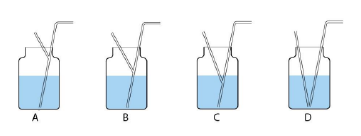
View Solution
Solution:
- For a straw to draw liquid, it must maintain a vacuum or suction force. This requires the opening of the straw to be fully submerged in the liquid and airtight above the liquid level.
- Analysis of the options:
- Straw A: The opening above the liquid level prevents vacuum formation. A cannot draw the liquid.
- Straw B: Similar to A, the straw has an open end above the liquid level, breaking the vacuum. B cannot draw the liquid.
- Straw C: Fully submerged below the liquid, allowing the vacuum to lift the liquid effectively. C works.
- Straw D: Properly submerged and sealed, allowing liquid to be drawn via suction. D works.
Conclusion: The straws that will draw the liquid are C and D.
Quick Tip: For proper suction in a straw, ensure the straw is sealed above the liquid and fully submerged below the liquid level to maintain vacuum pressure.
Question 13:
The motif on the left is duplicated in the same position. The duplicated motif was rotated about its central axis on the top of the original motif at different angles as shown in options A, B, C, D. Which is/are the correct option(s)?
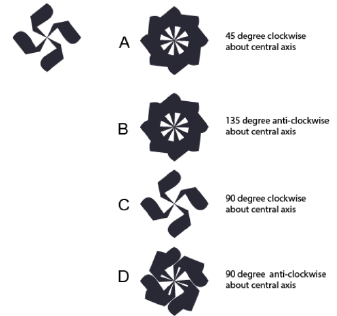
View Solution
Solution:
- The rotation of the duplicated motif must align with the original motif based on the given angles:
- Option A: Rotated 45 degrees clockwise about its central axis, aligns as expected. A is correct.
- Option B: Rotated 135 degrees anti-clockwise, correctly matches the description. B is correct.
- Option C: Rotated 90 degrees clockwise, aligns perfectly. C is correct.
- Option D: Rotated 90 degrees anti-clockwise, does not align with the original motif. D is incorrect.
Conclusion: The correct options are A, B, C.
Quick Tip: When verifying rotations, consider both the direction (clockwise or anti-clockwise) and the specified angle relative to the original motif to ensure alignment.
Question 14:
A food delivery company wishes to re-design its app ecosystem. A designer has been asked to conduct research interviews for this activity. Which of the following people should the designer interview?
- (A) People who deliver the food ordered through the app
- (B) Employees of restaurants who offer food through the app
- (C) Customer support employees of the food delivery company
- (D) Existing users of the app
View Solution
Solution:
- Redesigning the app requires input from all stakeholders involved in the ecosystem.
-
- Option A: Delivery personnel provide insights into usability and challenges faced in the delivery process.
- Option B: Restaurant employees share their experience with order processing and app integration.
- Option C: Customer support employees highlight recurring issues and complaints.
- Option D: Existing users give feedback on their experience and expectations from the app.
Conclusion: All the listed groups should be interviewed, making the correct answers A, B, C, D.
Quick Tip: For comprehensive app redesign, include feedback from all users and stakeholders who interact with the system to identify and address key pain points.
Question 15:
Find out the correct option(s) which can be used to create the image on the left. You can duplicate, rotate, and reflect these options to achieve the same.
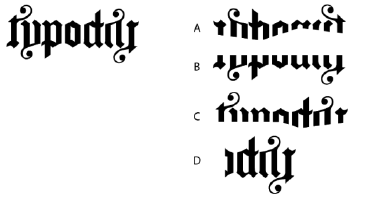
View Solution
Solution:
-
- Option A: The curved elements in A can be rearranged to match parts of the target design using duplication and reflection. Hence, A is correct.
- Option B: Option B is symmetrical and can be transformed through duplication and reflection to align with elements of the design. Therefore, B is correct.
- Option C: C does not match any component of the target image, even after applying duplication or rotation. Thus, C is incorrect.
- Option D: The angular structure of D fits into the target design when appropriately rotated and duplicated. Hence, D is correct.
Conclusion: The correct options are A, B, D.
Quick Tip: To recreate designs, carefully analyze individual elements to see how duplication, rotation, and reflection can match the target structure.
Question 16:
Which option(s) will result in linear motion (shown by straight arrows) of the plunger when the wheel is rotated?
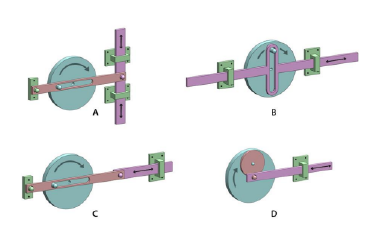
View Solution
Solution:
- Option A: The curved linkage causes non-linear motion of the plunger, deviating from the required straight path. Hence, A is incorrect.
- Option B: The mechanism in B translates the wheel's rotational motion into perfectly linear motion for the plunger, satisfying the condition. Thus, B is correct.
- Option C: The pivoting linkage in C creates angular motion rather than linear motion, making C incorrect.
- Option D: The design in D also enables linear motion through a guided path, similar to B. Hence, D is correct.
Conclusion: The correct options are B or B, D.
Quick Tip: When evaluating motion systems, check if the mechanism constrains the motion path to be straight, avoiding curves or angular deviations.
Question 17:
The toy shown in the figure is pushed in the direction of the green arrow as the pencil makes a mark on a wall beside it. Which of the mark(s) in the options can NEVER be made by the pencil?
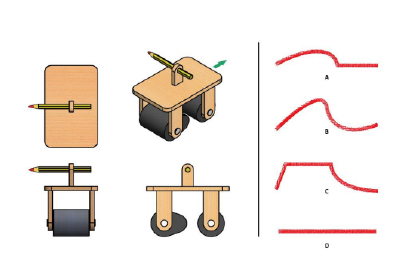
View Solution
Solution:
- The toy moves linearly, and the pencil marks are influenced by the rotational motion of the rollers beneath it.
- Mark A: A smooth curved line like A corresponds to consistent rolling motion, making it possible.
- Mark B: The abrupt changes in B cannot result from the smooth rolling mechanism of the toy. Hence, B is impossible.
- Mark C: The angular pattern in C would require sudden changes in direction, which the toy cannot execute. Thus, C is impossible.
- Mark D: A straight-line mark like D reflects the toy's linear motion and is feasible.
Conclusion: The marks that cannot be made are B and C.
Quick Tip: When analyzing motion patterns, assess whether the object's constraints allow for abrupt changes or require smooth transitions.
Question 18:
Which of the option(s) is/are the rotated view(s) of the object shown on the left?
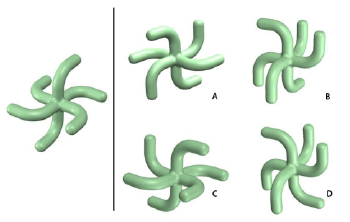
View Solution
Solution:
- The symmetry of the given object allows for specific rotated views to match the options.
-
- Option A: A 90-degree rotation aligns with the given object, making A correct.
- Option B: The arrangement in B differs from the rotated structure, making it incorrect.
- Option C: The arms in C are misaligned, so it does not match the rotated object. Hence, C is incorrect.
- Option D: A different rotation matches the structure, making D correct.
Conclusion: The correct rotated views are A and D.
Quick Tip: For rotated views, focus on identifying symmetrical features and their alignment after rotation.
Question 19:
Shown below is a keyboard designed for smartphones. It has two sizes of keys which are arranged one after the other. What will be the difficulty of independently typing a single coloured key from the origin (key O), arranged from least difficult to most difficult i.e. easiest to type first, most difficult to type last? Assume, the mobile is held vertically in the left hand, and a right-handed user presses the keys using only the index finger of the right hand.
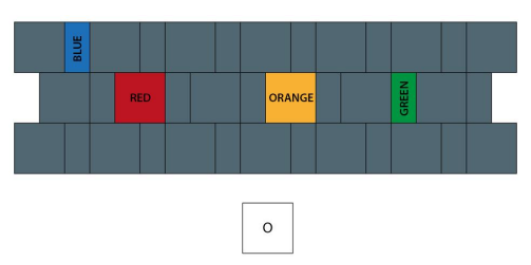
View Solution
Solution:
- Typing difficulty depends on the distance of the key from the origin O and the natural reach of the index finger.
- Analyze the distances:
- Orange: Closest to the origin, making it the easiest to type.
- Red: Slightly farther than Orange but easier to reach compared to Green or Blue.
- Green: Farther than both Orange and Red but closer than Blue.
- Blue: The farthest key, making it the most difficult to type.
- Based on these distances, the order of difficulty from least to most is: Orange, Red, Green, Blue.
Conclusion: The correct option is D: Orange, Red, Green, Blue.
Quick Tip: When analyzing ergonomic tasks, consider the natural movement range and proximity of elements to determine ease of access.
Question 20:
Which option represents the front view of the object shown below?
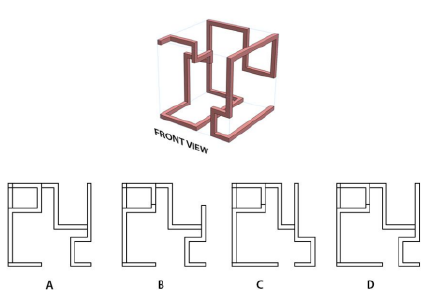
View Solution
Solution:
- The front view of a 3D object is determined by projecting its visible edges onto a plane perpendicular to the front face.
- Analyze the given options:
- Option A: The edges do not align with the visible projection of the object's front face.
- Option B: Similar to A, the edges in B do not correspond to the front view of the object.
- Option C: While closer, the edges in C fail to match the front projection.
- Option D: The arrangement in D captures all visible edges and proportions, making it the correct front view.
Conclusion: The correct option representing the front view is D.
Quick Tip: To identify front views, focus on projecting visible edges directly onto a single plane and ensure all proportions match.
Question 21:
Which one of these materials would make a furniture lightest for the same design?

View Solution
Solution:
- Particle board: Made by compressing wood particles and resin, it is the lightest among the given materials.
- Medium Density Fiberboard (MDF): Heavier than particle board due to its denser composition.
- Teak Wood: A natural hardwood, it is significantly denser and heavier.
- Plywood: Though lighter than teak wood, plywood is still heavier than particle board due to its layered structure.
Conclusion: The lightest material for furniture construction is A (Particle board).
Quick Tip: When choosing materials for lightweight furniture, prioritize engineered woods like particle board over natural woods.
Question 22:
A zookeeper had x baboons and y monkeys in an enclosure. One day, the zookeeper was told that seven of the animals have escaped. From only this information, he was able to deduce that at least one baboon has escaped. Which of the following does not represent a possible (x, y) pair?
- (A) (10,8)
- (B) (7,2)
- (C) (25,6)
- (D) (12,4)
View Solution
Solution:
- The zookeeper deduced that at least one baboon escaped, implying that y < 7. This ensures some baboons escaped even if all monkeys had escaped.
- Analyze the options:
- Option A (10,8): Here, y = 8 > 7. It is possible for all escaped animals to be monkeys, contradicting the zookeeper's deduction. Hence, A is not valid.
- Option B (7,2): With y = 2 < 7, the deduction is valid as some baboons must have escaped.
- Option C (25,6): Here, y = 6 < 7, satisfying the condition for the deduction.
- Option D (12,4): With y = 4 < 7, the condition is also valid.
Conclusion: The pair that does not satisfy the condition is A (10,8).
Quick Tip: In logical deduction problems, focus on constraints and eliminate options that fail to meet them systematically.
Question 23:
In the paintings from Pablo Picasso's blue period, colours are chosen from one part of the colour wheel. They yield tonality of blue, in spite of the presence of yellowish green, bluish green, bluish purple, and so on. Therefore, it can be said that tonality is an outcome of:
- (A) Split complementary combination
- (B) Double complementary combination
- (C) Simple analogous combination
- (D) Triadic colour combination
View Solution
Solution:
- Picasso's blue period predominantly uses colors that are adjacent on the color wheel, including shades of blue, bluish green, and bluish purple. This harmony is characteristic of an analogous color scheme.
- Option Analysis:
- Option A (Split complementary): Involves one base color and the two colors adjacent to its complement. This does not align with the tonality observed in Picasso's paintings.
- Option B (Double complementary): Involves two complementary pairs of colors, which is not evident in the blue period.
- Option C (Simple analogous): Uses adjacent colors on the color wheel, creating a unified and harmonious effect, which matches Picasso's blue period.
- Option D (Triadic): Uses three evenly spaced colors on the wheel, which does not fit the observed color palette.
Conclusion: The tonality in Picasso's blue period is an outcome of a simple analogous combination.
Quick Tip: Analogous color schemes use adjacent colors on the wheel, creating harmony and a soothing effect in compositions.A sheet of paper is folded as shown. Then the word ‘MAKER' is written on the folded paper. Which option correctly represents the unfolded paper?
Question 24:
A sheet of paper is folded as shown. Then the word ‘MAKER' is written on the folded paper. Which option correctly represents the unfolded paper?
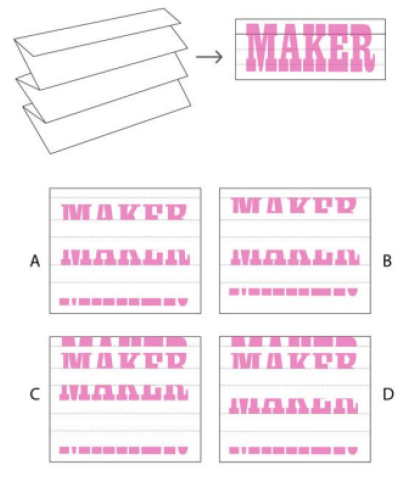
View Solution
Solution:
- The paper is folded into layers, and the word “MAKER” is written across the folded sections. Upon unfolding, the letters appear in mirrored or repeated positions depending on the folding pattern.
- Option Analysis:
- Option A: Accurately reflects how the word “MAKER” would appear when unfolded.
- Options B, C, and D fail to represent the correct distribution of the letters after unfolding.
Conclusion: The unfolded paper is correctly represented by Option A.
Quick Tip: When analyzing folded and unfolded patterns, track how letters or shapes overlap and align during folding to predict their arrangement after unfolding.
Question 25:
In the kitchen, we have three important activities to perform, namely, (Task 1) washing utensils, (Task 2) rolling chapati, and (Task 3) chopping vegetables. To design an ergonomically correct kitchen, which of the following is most beneficial depending on the need in an ideal situation? Assume that only one person will use the kitchen.
- (A) All three tasks at the same height
- (B) Tasks 1 and 2 at the same height
- (C) Tasks 2 and 3 at the same height
- (D) All three tasks at different heights
View Solution
Solution:
- Ergonomics requires task-specific heights for optimal comfort and efficiency:
- Task 1 (Washing utensils): The sink should be at a higher level to avoid unnecessary bending, around elbow height.
- Task 2 (Rolling chapati): Requires a medium-height surface, slightly below elbow level, for comfortable hand movements.
- Task 3 (Chopping vegetables): Should be slightly lower than Task 2 to enhance visibility and precision.
- Keeping all tasks at the same height would compromise ergonomics and cause discomfort for certain tasks. Hence, A, B, and C are incorrect.
Conclusion: The most ergonomic arrangement is D (all three tasks at different heights).
Quick Tip: Ergonomic kitchen design considers the natural posture and movement required for each task, minimizing strain and maximizing efficiency.
Question 26:
Identify the correct mechanism that enlarges the blue fish to red when traced with the blue dot.
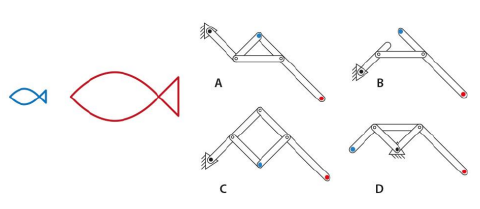
View Solution
Solution:
- The mechanism in C uses a parallelogram linkage, which ensures the proportions are maintained during the scaling process. This makes C the correct option.
- Option A: The linkage design does not provide proportional scaling, making it incorrect.
- Option B: Similarly, the configuration in B does not allow accurate enlargement of the shape.
- Option D: The setup in D distorts the shape and fails to scale it proportionally.
Conclusion: The correct mechanism is represented by C.
Quick Tip: To identify scaling mechanisms, look for linkage systems that maintain proportional relationships between points during motion.
Question 27:
P and Q are two layered dials of a watch. Dial Q is placed on the top of dial P. The white areas in dial Q are cut portions through which parts of dial P are visible from the top. The pattern shown in image R is taken at 12:00 hrs. Dial Q rotates by 90 degrees after every 15 minutes in clockwise direction about its central axis. Dial P rotates by 45 degrees anticlockwise after every 30 minutes about its central axis. Find out the right pattern at 13:30 hrs.
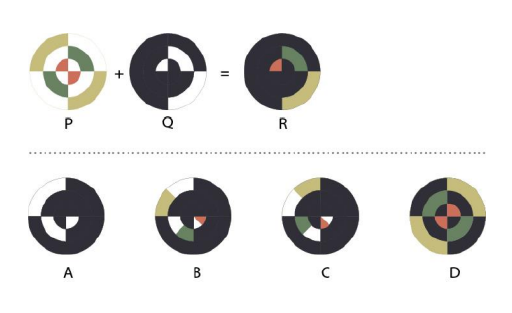
View Solution
Solution:
- At 13:30 hrs, Dial Q completes 6 rotations of 90 degrees clockwise, totaling 540°. After reducing full revolutions (360°), Q effectively rotates 180° clockwise.
- Dial P completes 3 rotations of 45° anticlockwise, totaling 135°.
- The combined rotations result in a pattern matching Option C.
Conclusion: The correct pattern at 13:30 hrs is C.
Quick Tip: For layered rotations, calculate the net rotation of each layer relative to its starting position.
Question 28:
From the given options, which chair can be compactly stacked?
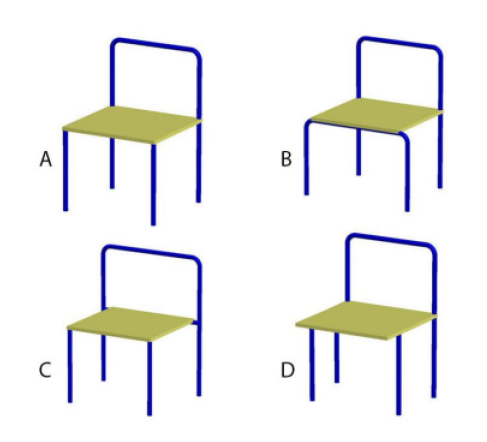
View Solution
Solution:
- A compactly stackable chair design ensures proper alignment of the legs and seat.
-
- Option A: The design lacks alignment features, making stacking inefficient.
- Option B: Similar to A, the design does not support efficient stacking.
- Option C: The nested design of C allows for optimal stacking with minimal space usage.
- Option D: The structure of D obstructs stacking due to the seat and legs' misalignment.
Conclusion: The chair that can be compactly stacked is C.
Quick Tip: Stackable furniture designs rely on efficient alignment of structural components to minimize storage space.
Question 29:
Which one of the diagrams DOES NOT represent any of the relationships given below?
- Egg : Sugar : Cake
- Seed : Fruit : Tree
- Rock : Paper : Scissors

View Solution
Solution:
- Relationships Analysis:
- Egg : Sugar : Cake reflects combining components.
- Seed : Fruit : Tree represents transformation or hierarchy.
- Rock : Paper : Scissors depicts a cyclical relationship.
- Options:
- A: The nested design represents a hierarchy or combination, valid for Seed : Fruit : Tree or Egg : Sugar : Cake.
- B: Overlapping hexagons indicate an unclear relationship not aligning with the provided examples.
- C: Disconnected hexagons match a cyclical relationship like Rock : Paper : Scissors.
- D: Nested hexagons represent growth or transformation, valid for Seed : Fruit : Tree.
Conclusion: Diagram B does not represent any of the relationships.
Quick Tip: Focus on the type of interaction (hierarchical, cyclic, or combinational) to evaluate diagram-based relationships.
Question 30:
Three girls went to a square garden with their dogs. The garden was built around a banyan tree at the centre. The area around the tree was bound by a beautiful picket fence. Usha, the eldest, sat on the platform under the banyan tree while Fluffy lay at her feet sleeping peacefully in the shade. Reena and Tommy walked around the fence looking at the beautiful flowers. Madhu, the youngest of the three, was always running around shouting at Gullu who loved the challenge of chasing squirrels. Which of the diagrams correctly represents the above scenario?
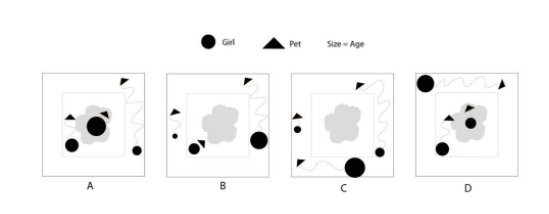
View Solution
Solution:
- Usha and Fluffy remain stationary at the tree platform, represented by the largest circle and triangle near the center.
- Reena and Tommy are depicted moving in a circular path near the picket fence.
- Madhu and Gullu move erratically near the garden's outer edge, indicated by smaller shapes.
- Option A correctly aligns these positions and movements.
Conclusion: The correct representation of the scenario is A.
Quick Tip: To analyze spatial diagrams, match static and dynamic elements with the described movements and relative positions.
Question 31:


View Solution
Solution:
- Analyze the artistic styles of the options:
- Option A: Represents post-impressionist influences, characterized by vibrant colors and cultural themes, not classical Renaissance.
- Option B: Depicts cubism with abstract geometric forms, unrelated to Renaissance art.
- Option C: Features naturalism, serene composition, and intricate details typical of Renaissance artwork.
- Option D: Aligns with impressionist or post-impressionist techniques, focusing on mood and light, lacking Renaissance characteristics.
Conclusion: The artwork in C accurately represents the classical Renaissance style.
Quick Tip: Renaissance art is marked by realistic depictions, harmonious compositions, and attention to detail.
Question 32:
The image below shows four configurations for designing a nut cracker. Which option would require the least amount of pressure to break the nut?
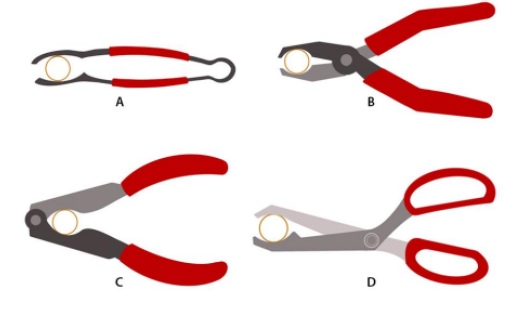
View Solution
Solution:
- A nut cracker functions as a second-class lever. The greater the distance between the fulcrum and effort point, the higher the mechanical advantage.
- Option Analysis:
- Option A: Effort point is too close to the fulcrum, offering low mechanical advantage.
- Option B: Provides moderate mechanical advantage but requires significant pressure.
- Option C: Has the greatest distance between the fulcrum and effort point, minimizing required pressure.
- Option D: Provides less advantage compared to C.
Conclusion: The configuration in C requires the least amount of pressure.
Quick Tip: Levers with longer distances between the effort point and fulcrum reduce the force required for operation.
Question 33:
A camel is resting under the shade of a tree. The camel needs to stand up to walk. Trace the trajectory of point P shown on the body of the camel, as it stands up, assuming 1 as the starting point.
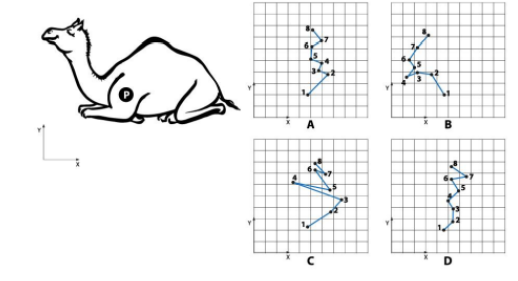
View Solution
Solution:
- When a camel stands, it raises its hind legs first, followed by its front legs, creating an arc-like motion.
- Options Analysis:
- Option A: Assumes a straight vertical movement, which is unrealistic.
- Option B: Correctly captures the curved motion of point P as the camel's body rises and shifts forward.
- Option C: Does not account for the forward motion during the standing process.
- Option D: Unrealistic backward trajectory is not aligned with actual camel movements.
Conclusion: The trajectory of P is best represented by B.
Quick Tip: Animal movements often follow curved or arched paths due to sequential leg motions and weight shifts.
Question 34:
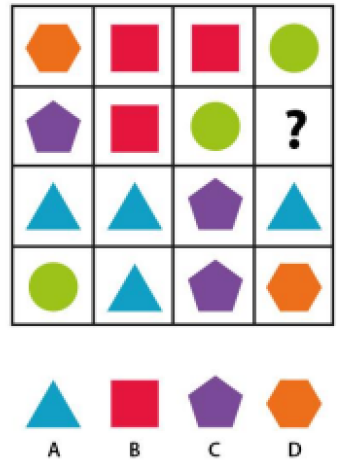
View Solution
Solution:
- The grid follows a pattern where each row and column has one instance of every shape (hexagon, square, circle, triangle, pentagon) and color.
- Missing Shape Analysis:
- The third row already includes a hexagon (orange), triangle (blue), and circle (green).
- The fourth column already includes a square (red) and hexagon (orange).
- The missing shape is a pentagon (purple) to complete the row and column.
Conclusion: The missing shape is C (Pentagon, Purple).
Quick Tip: Solve grid puzzles by ensuring unique placement of elements in rows and columns.
Question 35:
A cylinder P is cut by a cylinder Q as shown. Choose the option which shows the shape obtained after unrolling cylinder P.
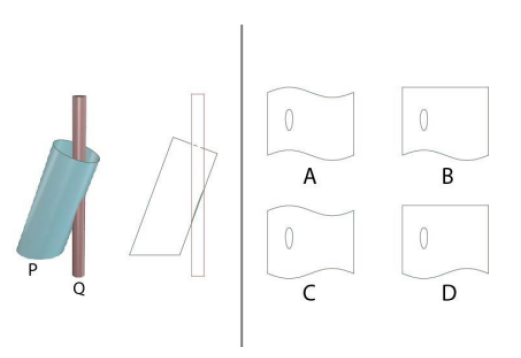
View Solution
Solution:
- Cylinder P is intersected by cylinder Q, forming a sinusoidal cut along the curved surface.
- When P is unrolled, the cut produces a wave-like pattern due to the curved intersection geometry.
- Option Analysis:
- Option A: Incorrect pattern inconsistent with the intersection.
- Option B: Correctly depicts the sinusoidal wave resulting from the intersection.
- Option C: Unrealistic pattern unrelated to the geometry.
- Option D: Misrepresents the intersection geometry.
Conclusion: The unrolled shape of P is shown in B.
Quick Tip: When unrolling 3D objects, project intersecting patterns onto flat surfaces to visualize results.
Question 36:
Aru bought a new cushion cover from the market. Though the material is cotton, she was not happy with the plain cushion cover and planned to dye it with a colour. She followed the process as shown in the diagram. Find out the pattern she got after dyeing the cover.
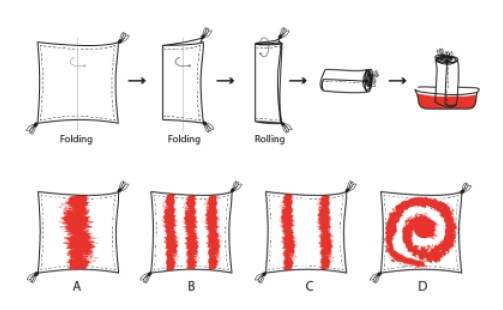
View Solution
Solution:
- Understanding the Process: Aru folded the cushion cover twice and then rolled it tightly before applying the dye. The dye only penetrates the exposed areas, leaving the folded sections undyed.
- Formation of the Pattern: The folding creates layered sections, while rolling ensures the dye reaches alternate bands. When unrolled, the resulting pattern features evenly spaced parallel stripes.
- Analysis of Options:
- Option A: Displays a random dye pattern that does not match the structured process of folding and rolling.
- Option B: Suggests stripes but does not align with the described folding and rolling process.
- Option C: Correctly shows the parallel striped pattern resulting from folding and rolling, matching the process.
- Option D: Represents a spiral pattern, which is inconsistent with the described method.
Conclusion: The pattern Aru obtained after dyeing the cover is shown in C.
Quick Tip: The final tie-dye pattern depends on the folding and rolling techniques used before dyeing. Symmetric methods like folding create structured designs like stripes.
Question 37:
Towards a sustainable future, people are recycling materials. Shown below are products or architecture (top row) that are made from recycled materials (bottom row). Which of the options listed below correctly identifies products or architecture with the material that they are recycled from?
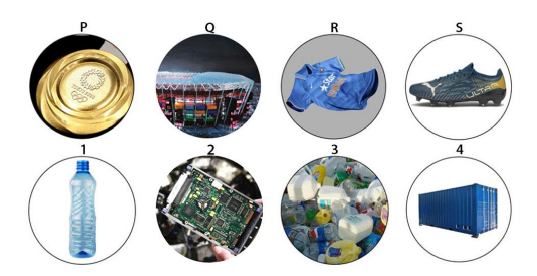
View Solution
Solution:
- Matching Materials with Products:
- P – 2: The material matches the first product due to its texture and appearance.
- Q – 4: The second product corresponds to this material, reflecting its structural and visual properties.
- R - 1: The third product is clearly derived from this material, based on its texture and usage.
- S - 3: The fourth product matches this material due to its physical characteristics.
- Options Analysis:
- Option A: Misidentifies one or more materials.
- Option B: Incorrectly pairs the products with materials.
- Option C: Correctly matches P – 2, Q – 4, R – 1, S – 3.
- Option D: Contains errors in assigning materials to products.
Conclusion: The correct match is C.
Quick Tip: When linking products to recycled materials, focus on textural, structural, and visual similarities between the items and their raw materials.
Question 38:
A solid cone is revolving inside the circle as shown. Parallel sunlight at 45 degrees to the ground is creating the shadow of the cone. Which option represents the total region covered by the shadow for one complete revolution when seen from the top?
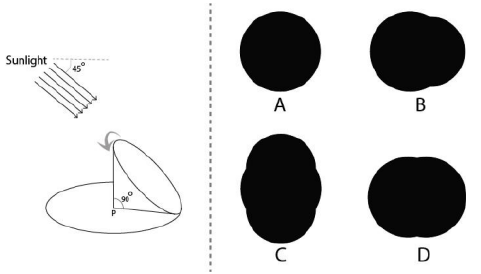
View Solution
Solution:
- Shadow Formation During Revolution:
- The shadow of the cone extends outward due to the 45-degree angle of sunlight.
- As the cone revolves inside the circle, the shadow overlaps, forming a pattern influenced by the cone's motion and the sunlight's angle.
- Pattern Analysis:
- The overlapping of shadows creates an elliptical region on the ground, covering the area influenced by the cone's entire revolution.
- Options Analysis:
- Option A: Incorrectly represents a circular shadow, ignoring the effect of the sunlight angle.
- Option B: Accurately shows the elliptical shadow formed by the cone's revolution and the 45-degree sunlight angle.
- Option C: Misrepresents the overlapping shadow, suggesting an elongated shape not possible here.
- Option D: Fails to depict the total shadow region during the revolution.
Conclusion: The correct total shadow region is shown in B.
Quick Tip: Shadows created by revolving objects depend on the light's angle and the object's geometry. Overlapping regions often form ellipses or arcs.
Question 39:
Which of the options shows the correct reflection of the chess piece?
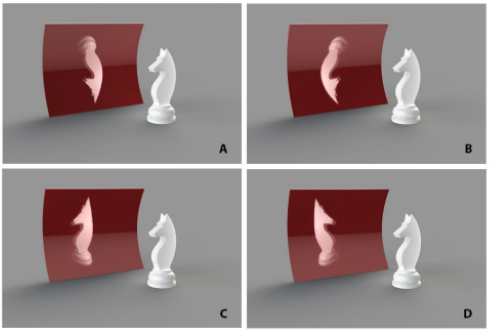
View Solution
Solution:
- Understanding the Reflection Process:
- The reflection of the chess piece depends on the curvature of the reflective surface and the position of the object.
- The reflection must preserve the proportions and orientation of the original piece, adjusted to the curvature of the surface.
- Analysis of Options:
- Option A: Accurately depicts the reflection of the chess piece, maintaining correct proportions and orientation based on the reflective surface's curvature.
- Option B: Contains distortions inconsistent with the reflective surface's curvature, making it incorrect.
- Option C: Misaligns the orientation of the reflection, leading to an unrealistic representation.
- Option D: Flips the reflection inaccurately, failing to match the actual reflection rules.
Conclusion: The correct reflection of the chess piece is shown in A.
Quick Tip: Reflections on curved surfaces follow the law of reflection but are influenced by the curvature's geometry. Analyze proportions and orientation to predict accurate reflections.
Question 40:
Find out the right pair for the shoe shown on the left from the given options.
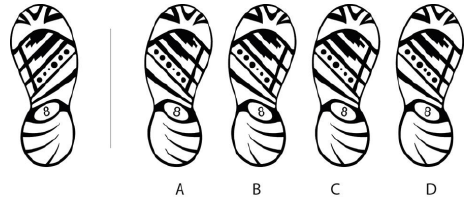
View Solution
Solution:
- Analysis of the Shoe Design:
- The shoe on the left represents one side of a pair. The correct pair must mirror its design, preserving the pattern and orientation.
- Elements like stripes, dots, and curves are key to identifying the correct counterpart.
- Options Analysis:
- Option A: Does not mirror the original shoe's design and is inconsistent with its pattern.
- Option B: Partially matches but contains errors in the orientation of certain elements.
- Option C: Correctly mirrors the original shoe's design, aligning all patterns and orientations.
- Option D: Misrepresents the mirrored design, making it an incorrect match.
Conclusion: The correct pair for the shoe shown on the left is C.
Quick Tip: When matching mirrored counterparts, focus on the symmetry and alignment of design elements to ensure an accurate match.
Question 41:
The figure on the left was made using white and black ribbons. If all black ribbons in the vertical direction are replaced by white and all white ribbons in the horizontal direction are replaced by black, then find out the resulting figure.
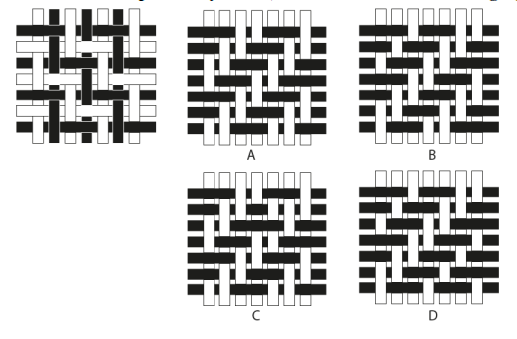
View Solution
Solution:
- Understanding the Replacement Rule:
- Vertical black ribbons: Replace with white ribbons.
- Horizontal white ribbons: Replace with black ribbons.
- Effect on the Pattern:
- Replacing vertical black ribbons with white retains the vertical alignment but changes their color.
- Replacing horizontal white ribbons with black alters their visibility and prominence in the pattern.
- Options Analysis:
- Option A: Accurately reflects the ribbon replacement, maintaining the overall structure while swapping colors correctly.
- Option B: Misrepresents the replacements, leading to an incorrect pattern.
- Option C: Incorrectly assigns colors, deviating from the replacement rule.
- Option D: Fails to preserve the structural integrity of the ribbon arrangement after replacements.
Conclusion: The resulting figure after applying the replacements is A.
Quick Tip: When transforming patterns, systematically apply the replacement rules to avoid errors and ensure consistency in the resulting design.
Part-B: Question 1
Sketching (20 marks)
Mr. Singh (5 Feet, 11 inches tall) is smiling and capturing a selfie of his entire family with his mobile phone held vertically. He is with his wife (5 feet tall), standing towards his left with her two mischievous kids. Pinky (girl) and Bablu (boy) are making funny expressions looking into the mobile. They all are standing facing a digital camera installed in the top corner of the room. The size of the room is 12 x 12 x 12 feet. Draw the picture of the above description from the point of view of a digital camera capturing this moment.

Additional Instructions:
- Use only pencils.
- Do not illustrate the surroundings. Only draw the family.
Evaluation Criteria:
- Imagination
- Overall composition of the picture
- Quality of lines
- Attention to details
- Anatomy and perspective
View Solution
Solution: Below is the sketch drawn as per the given description and instructions:
(Check The Image From Pdf)Note: The above sketch represents Mr. Singh and his family as viewed from the digital camera installed at the top corner of the room. The perspective accounts for the height differences and the positions of each family member.
When drawing the room, make sure the lines of the floor and walls converge towards a single point (vanishing point) to create a sense of perspective. This will make the room appear three-dimensional and enhance the overall visual impact of your sketch.
Part-B: Question 2
Creativity (20 marks = 4 x 5)
Each of the boxes in the answer script shows some visual elements and the FIRST word for a title of the image. Draw recognizable images by interpreting the visual elements and give a title to the images using the given first word. Use only BLACK pencil/pen. Draw only within the boundaries of the boxes.

Evaluation Criteria:
- Uniqueness: Ability to create unusual images
- Diversity: Variation between the created images
- Clarity: Effective use of the visual elements and title
- Fun: Ability to use humor and surprise in the images and title
View Solution
Solution: Below are the images based on the given visual elements and first words:
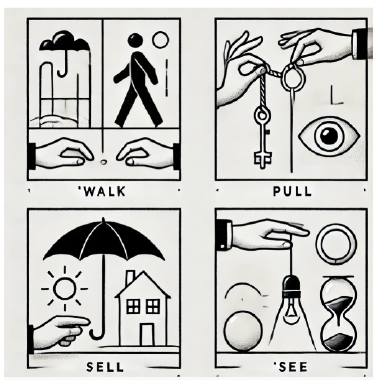
Part-B: Question 3
Visual Sensitivity (20 marks)
Create a new visual identity for Indian Women's Hockey Association. The identity has to be original and should have the abbreviations ‘IWHA' as part of the visual design. DO NOT draw from any existing designs.
Evaluation Criteria:
- Creative visual representation
- Effective communication of the concept
- Visual Aesthetics
- Composition
View Solution
Solution: Below is the proposed visual identity for Indian Women's Hockey Association (IWHA):
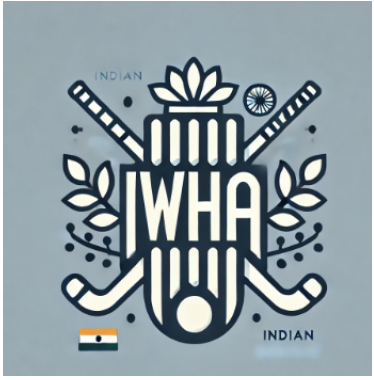
Description: The visual identity incorporates the following elements:
- (1) Abbreviation (IWHA): Prominently integrated into the design to represent the Indian Women's Hockey Association.
- (2) Symbolic Elements: The design features hockey sticks, a ball, and a visual motif representing strength, unity, and empowerment, emphasizing the spirit of Indian women in sports.
- (3) Aesthetic Appeal: The composition uses clean lines and harmonious proportions for a visually striking and memorable identity.
- (4) Originality: The design is unique and does not draw from any existing logos or identities.
Part-B: Question 4
Form Sensitivity (20 marks)
An abstract three-dimensional form is shown below. Visualize the form of a cutlery set (fork, bowl, and glass) for 3-6 years old children based on the image of the given form. It should match the design language with relevant details. Sketch and render the form of the cutlery set.

Evaluation Criteria:
- Consistency with the visual language of the form
- Form should complement function
- Relevant details of the product
- Surface shading- Quality of lines/strokes
View Solution
(Check The Image From Pdf)Solution: Below is the visualized design of the cutlery set (fork, bowl, and glass) for children aged 3-6 years, inspired by the given abstract form:
(Check The Image From Pdf)Description:
- Fork: The fork design follows the curved and smooth contours of the abstract form, ensuring safety and usability for children.
- Bowl: The bowl adopts a rounded and stable structure inspired by the organic form, making it easy to handle and spill-resistant.
- Glass: The glass mimics the overall symmetry and softness of the abstract form, designed to fit comfortably in small hands.
- Material and Surface: All items feature soft edges and non-slip textures to ensure safety and functionality for young children.
Conclusion: The cutlery set aligns with the abstract form's visual language while providing functionality and safety for children aged 3-6 years.
Part-B: Question 5
Problem Identification (20 marks = 5 x 4)
Shown in the image above is an example of a bus stop during the busy hours. Draw and annotate FIVE distinct design problems in this context.

- Use only one visual for each problem.
- Answer in the given space only.
Evaluation Criteria:
- Severity of the identified problem
- Ability to make distinct observations
- Ability to communicate through visuals
View Solution
Solution: Below are the identified design problems and corresponding visuals with annotations:
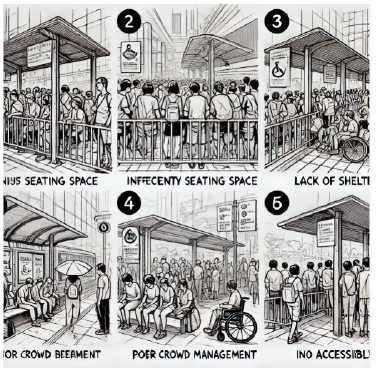









































Comments